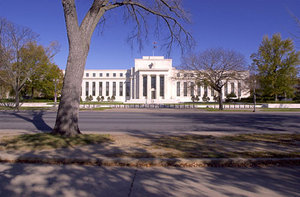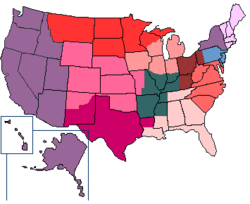Federal Reserve
|
|
Federal_Reserve.jpg
The Federal Reserve System (also the Federal Reserve; informally The Fed) is the central bank of the United States.
The Federal Reserve System is composed of a central Board of Governors in Washington, D.C. and twelve regional Federal Reserve Banks located in major cities throughout the nation. Alan Greenspan currently serves as the Chairman of the Board of Governors of Federal Reserve.
| Contents |
History
Main article: History of the Federal Reserve
Chartered in 1791, the first institutions with responsibilities of a central bank in the US were the First Bank of the United States and Second Bank of the United States. From 1837 to 1862, in the Free Banking Era there was no formal central bank, while from 1862 to 1913, a system of (private) national banks were in charge.
The Fed was created by the U.S. Congress through the passing of the Owen-Glass Act, signed by President Woodrow Wilson on December 23, 1913.
Roles and responsibilities
The main tasks of the Federal Reserve are:
- Supervise and Regulate banks
- Implement Monetary Policy by buying and selling U.S. Treasury Bonds
- Maintain a strong payments system
- Feds cannot issue U.S. Treasury Bonds
Other tasks include:
- Economic education
- Community outreach
- Economic research
Organization of the Federal Reserve
The Federal Reserve is comprised of a board of governors. The 7 members of the board are appointed by the President and confirmed by the Senate. Members are elected to terms of 14 years, with the ability to serve for no more than one term. A governor may serve the remainder of another governor's term in addition to their own full term. The Federal Open Market Committee (FOMC) comprises the 7 members of the board of governors and 5 representatives selected from the Federal Reserve Banks. The representative from the 2nd District, New York, is a permanent member, while the rest of the banks rotate on two and three year intervals.
The current members of the Board of Governors are:
- Alan Greenspan, Chairman
- Roger W. Ferguson, Jr., Vice-Chairman
- Edward Gramlich
- Susan Bies
- Mark Olson
- Ben Bernanke
- Donald Kohn
Interest rates
Federal_Funds_Rate_(effective).png
The Federal Reserve implements monetary policy largely by steering the federal funds rate, also called the overnight rate. The Federal Reserve has the power to set the federal funds rate by fiat. This is the interest rate that banks charge each other for overnight loans to one another. This in turn influences the prime rate which is usually about 3 percentage points higher than the federal funds rate. This prime rate is the rate that most banks price their loans at for their best customers.
Lower interest rates stimulate economic activity by lowering the cost of borrowing, making it easier for consumers and businesses to buy and build. Higher interest rates slow the economy by increasing the cost of borrowing. (See monetary policy for a fuller explanation.)
The Federal Reserve usually adjusts the federal funds rate by 0.25 or 0.50 percentage points at a time. From early 2001 to mid 2003 the Federal Reserve lowered its interest rates 13 times, from 6.25 to 1.00 percent, to fight recession. In November 2002, rates were cut to 1.75, and many interest rates went below the inflation rate. On June 25, 2003, the federal funds rate was lowered to 1.00 percent, its lowest nominal rate since July, 1958, when the overnight rate averaged 0.68 percent. Starting at the end of June, 2004, the Federal Reserve started to raise the target interest rate in response to concerns about the potential for increased inflation from a too-active economy. As of May 2005, the rate is at 3 percent following a series of increments.
The Federal Reserve has limited impact on longer-term interest rates. It can use open market operations to cause marginal changes in market yields, but its "buying power" on the market is significantly smaller than private institutions. The Fed can also attempt to "jawbone" the markets into moving towards the Fed's desired rates, but this is not always effective.
The Reserve Banks
The twelve regional Federal Reserve Banks, which were established by the Congress as the operating arms of the nation's central banking system, are organized much like private corporations—possibly leading to some confusion about “ownership.” For example, the Reserve Banks issue shares of stock to member banks. However, owning Reserve Bank stock is quite different from owning stock in a private company. The Reserve Banks are not operated for profit, and ownership of a certain amount of stock is, by law, a condition of membership in the System. The stock may not be sold or traded or pledged as security for a loan; dividends are, by law, limited to 6 percent per year.[1] (http://minneapolisfed.org/info/sys/faq/frs.cfm#3)
The dividends paid to member banks are considered partial compensation for the lack of interest paid on member banks' required reserves held at the Fed. By law, banks in the United States must maintain fractional reserves, most of which are kept on account at the Fed. The Federal Reserve does not pay interest on these funds.
The Federal Reserve System was created via the Federal Reserve Act of 1913 which "established a new central bank designed to add both flexibility and strength to the nation's financial system. The legislation provided for a system that included a number of regional Reserve Banks and a seven-member governing board. All national banks were required to join the system and other banks could join. The Reserve Banks opened for business in November 1914. Congress created Federal Reserve notes to provide the nation with an elastic supply of currency. The notes were to be issued to Reserve Banks for subsequent transmittal to banking institutions in accordance with the needs of the public.
Who owns the Federal Reserve?
The Federal Reserve claims that nobody owns it – that it is an “independent entity within the government.” The Federal Reserve is subject to laws such as the Freedom of Information Act and the Privacy Act which cover Federal agencies but not private corporations; yet Congress gave the Federal Reserve the autonomy to carry out its responsibilities insulated from political pressure. Each of the Federal Reserve's three parts – the Board of Governors, the regional Reserve banks and the Federal Open Market Committee – operates independently of the federal government to carry out the Federal Reserve's core responsibilities. Once a member of the Board of Governors is appointed, he or she can be as independent as a U.S. Supreme Court judge, though the term is shorter.
In the 1982 case, Lewis v. United States, the Ninth Circuit Federal Court of Appeals stated that the "Federal reserve banks are not federal instrumentalities for purposes of a Federal Torts Claims Act, but are independent, privately owned and locally controlled corporations.". The opinion also went on to state that "The Reserve Banks have properly been held to be federal instrumentalities for some purposes."
Influence of Government
As the nation's central bank, the Federal Reserve derives its authority from the US Congress. It is considered an independent central bank because its decisions do not have to be ratified by the President or anyone else in the executive or legislative branch of government, it does not receive funding appropriated by the Congress, and the terms of the members of the Board of Governors span multiple presidential and congressional terms. The Federal Reserve's financial independence arises because it is hugely profitable, among others, due to its ownership of government bonds. It returns billions of dollars to the government each year. However, the Federal Reserve is subject to oversight by the Congress, which periodically reviews its activities and can alter its responsibilities by statute. Also, the Federal Reserve must work within the framework of the overall objectives of economic and financial policy established by the government.
Money creation and fractional reserve banking
Money creation: The regulation of the creation of new money in the economy by commercial and central banks.
Fractional reserve banking: The common practice by banks of retaining only a fraction of their deposits to satisfy demands for withdrawals, lending the remainder at interest to obtain income that can be used to pay interest to depositors and provide profits for the banks' owners.
Criticism
Main article: Criticism of the Federal Reserve
Criticism of the federal reserve include what may be general criticism of a central bank system, for example that it cartelizes the banking industry and monopolizes the creation of money. And what may be specific federal reserve criticism, that it profits illegally, and causes inflation.
A criticism that is less frequently used is that the U.S. Congress is given by Article 1, Section 8, Clause 5 of the U.S. Constitution "To coin Money, regulate the Value thereof, and of foreign Coin, and fix the Standard of Weights and Measures." Critics of the system assert that the transfer of this power to a private corporation is unconstitutional.
Further reading
- Griffin, Edward G. (1998). "The Creature from Jekyll Island:A second look at the Federal Reserve". American Media. ISBN 0912986212.
- Greider, William (1987). Secrets of the Temple. Simon & Schuster. ISBN 0671675567; a book intended for lay readers explaining the structures, functions, and history of the Federal Reserve.
- Epstein, Lita & Martin, Preston (2003). The Complete Idiot's Guide to the Federal Reserve. Alpha Books. ISBN 0028643232.
- Meyer, Lawrence H (2004). A Term at the Fed : An Insider's View. HarperBusiness. ISBN 0060542705.
- Rothbard, Murray N. (1994). The Case Against the Fed. Ludwig Von Mises Institute. ISBN 094546617X.
- Who Owns and Controls the Federal Reserve? http://www.usagold.com/FederalReserve.html
See also
- Central bank
- Discount window
- Economic reports
- Federal Reserve Banks
- Government debt
- Money market
- Money supply
- Open Market Operations
External links
- FED101 (http://www.federalreserveeducation.org/fed101/index.htm)
- Board of Governors of the Federal Reserve System (http://www.federalreserve.gov)
- Federal Reserve Routing Directory (http://www.fededirectory.frb.org/)
- Gross Federal Debt History Fact Sheet (http://www.treas.gov/education/fact-sheets/taxes/fed-debt.html)
Articles
History
- A Foregone Conclusion - St. Louis Fed (http://www.stlouisfed.org/publications/foregone/chapter_two.htm)
- Federal Reserve Bank of Minneapolis - The Region - Paul Warburg's Crusade to Establish a Central Bank in the United States (May 1989) (http://minneapolisfed.org/pubs/region/89-05/reg895d.cfm)
Other
- Know your Fed: A description of the Federal Reserve Board (http://www.bankrate.com/nltrack/news/fed/20010627d.asp)
- Opposition to the Fed (http://www.federal-reserve.net)
- Congress should stand up to the Fed (http://www.nader.org/interest/021500.html) by Ralph Nader
- Billions for bankers, debt for the people By Sheldon Emry (http://www.tradersclub.com/dollarsign/billionsforbankers.shtml)
- Secrets of the Federal Reserve (http://www.apfn.org/apfn/reserve.htm) by Eustace Mullins (Makes arguments about the New World Order owning stock in the Fed, when it is banks that actually own the stock as mentioned above)
- Template:Book reference; specifically, Chapter 10
- Who Owns the Fed? (http://libertyunbound.com/archive/2004_10/woolsey-fed.html) Liberty article by Bill Woolsey.
- What Has Government Done to Our Money? (http://www.mises.org/money.asp) by Murray N. Rothbardde:Federal Reserve System
fr:Réserve fédérale des États-Unis ja:連邦準備制度 no:Federal Reserve zh:美国联邦储备系统


